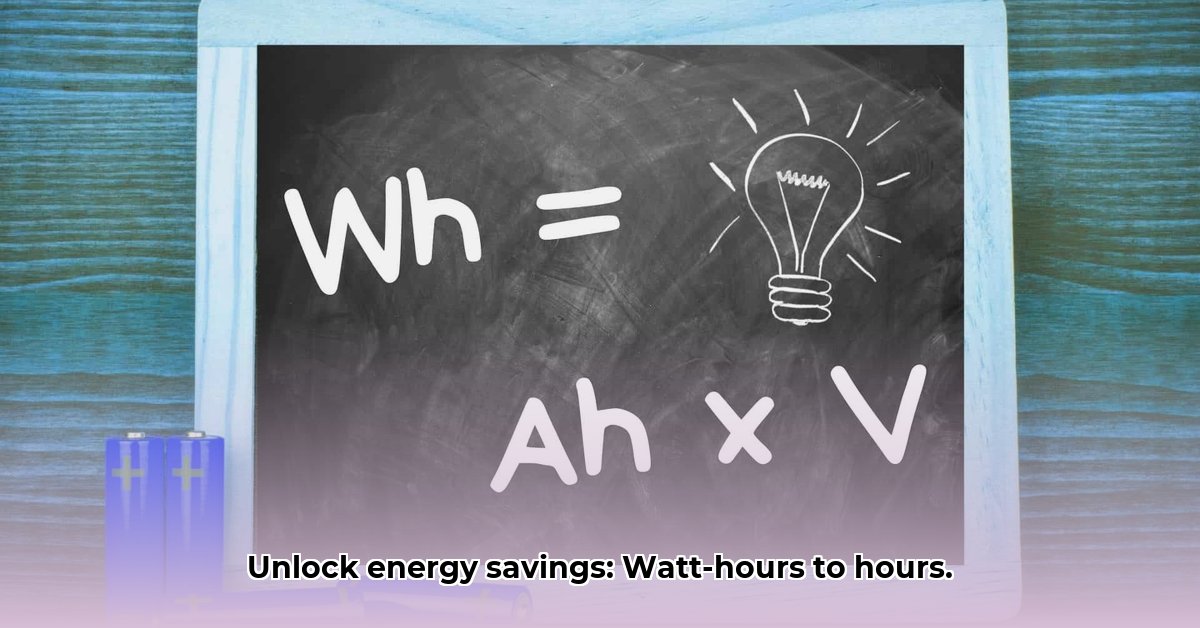Want to save money and be smarter about your energy use? It all starts with understanding watt-hours. This guide will show you how to figure out how much energy your stuff uses, from your phone to your fridge to your whole solar setup. We’ll break it down in simple terms, with easy-to-follow examples, so you can easily calculate energy needs and make better choices about your power. Whether you’re a total beginner or already pretty handy, you’ll find helpful tips and tricks to manage your energy more efficiently. For more on long-term energy calculations, see this helpful guide on long-term energy use. Let’s get started!
Decoding Watt Hours: Your Guide to Energy Efficiency
Let’s talk about energy – specifically, how to understand and manage it better. This guide will unravel the mystery of watt-hours and show you how they fit into your daily life, from powering your home appliances to prepping for a camping trip with a portable power station. Understanding these concepts can be very empowering, and it’s much simpler than you might think!
Understanding the Basics: Watts and Watt-Hours – What’s the Difference?
Think of filling a bucket with water. Watts are like the faucet’s flow rate – a wide-open faucet fills the bucket quickly, while a slow drip takes much longer. Watts measure power, which is the rate at which energy is used. A 100-watt light bulb uses energy faster than a 60-watt bulb.
Watt-hours, on the other hand, represent the total amount of water collected in the bucket. They tell you the total amount of energy used over a period of time. A 100-watt bulb running for one hour uses 100 watt-hours (Wh) of energy. If that same bulb runs for two hours, it uses 200 Wh. Watts are the rate, and watt-hours are the total accumulation. Understanding this distinction is key to saving energy and money.
The Simple Math: Converting Watt-Hours to Hours (and Vice Versa)
The core formula is straightforward:
Watt-hours (Wh) = Watts (W) × Hours (h)
Let’s say you have a 300 Wh portable power station and want to run a device that consumes 30W. How long will it last?
Hours = Watt-hours / Watts
Hours = 300 Wh / 30 W = 10 hours
Easy, right?
What if your battery information is in amp-hours (Ah) instead of watt-hours? No problem! You just need to know the battery’s voltage (V).
Watt-hours (Wh) = Amp-hours (Ah) × Voltage (V)
For example, a 12V battery with 20 Ah has a capacity of 240 Wh (20 Ah x 12V). Always check the voltage, as higher voltage batteries will affect calculations.
Real-World Applications: Using Your Knowledge
This isn’t just theoretical; it’s incredibly practical. Here are some real-world applications:
Home Energy Management: Saving Money on Electricity Bills
Ever wondered how much electricity your refrigerator uses? Understanding watt-hours helps you figure it out and estimate your costs.
Let’s say your fridge uses 150W on average and runs for approximately 8 hours per day due to its thermostat cycling on and off. That’s 1200 Wh (150W x 8 hours) daily!
Tracking appliance energy consumption helps identify ways to cut back and save money. Replacing older appliances with energy-efficient models can significantly reduce electricity bills.
Portable Power Stations: Power on the Go!
Portable power stations are rated in watt-hours, making our formula essential for planning your power needs. Before buying one, calculate the estimated watt-hours needed for your devices. If your phone charger uses 5W, then a 500 Wh power station is more than enough for multiple charges. But if your laptop needs 60W, you’ll need a larger power station for extended usage.
Solar Power Systems: Powering Your Life with the Sun
Solar panels generate power in watts, and the size of your system – including the battery storage – depends on your daily energy needs in watt-hours. The more watts your panels produce and the more hours of sunlight you receive, the more watt-hours you generate. Planning your solar setup requires understanding watt-hours to ensure enough energy is stored to meet your needs.
Advanced Considerations: Real-World Factors Affecting Energy Consumption
The real world is rarely as efficient as textbook examples. Here are some complications to consider:
- Efficiency Losses: Appliances aren’t 100% efficient; some energy is lost as heat due to the conversion process. The actual energy used might be slightly higher than the rated wattage.
- Variable Power Consumption: Devices rarely use a constant wattage. A computer might draw more power when processing data.
- Standby Power: Many devices consume power even when turned off, known as “phantom load” or “vampire power.”
- Battery Degradation: Rechargeable batteries lose capacity over time, reducing the available watt-hours.
- Temperature: Battery performance is affected by temperature; extreme heat or cold can reduce capacity.
These factors become more crucial as you deal with larger systems or more precise energy management. Inefficiencies in energy systems can lead to an increase in energy consumption.
Troubleshooting Common Issues
- Calculations seem inaccurate: Double-check your units (W, Wh, V, Ah). Ensure you’re applying the correct formula.
- Energy usage is higher than expected: Check for energy vampires, faulty appliances, and inefficient energy usage habits. Check that appliances are running efficiently and not needing repair.
Understanding the connection between watts and watt-hours empowers you to make smarter decisions about energy use. By aligning your power sources with your energy needs, you can improve energy efficiency, save money, and make sustainable choices for your home and lifestyle.
Mastering Watt Hours for Portable Power Stations: Extended Guide
Key Considerations:
- Understanding watt-hours (Wh) is crucial for managing portable power station battery life effectively.
- Calculating watt-hours for portable power station battery life is a practical skill.
- Accurate calculations ensure you select the right-sized power station for your needs.
- Efficiency losses and real-world usage affect runtime.
- Advanced factors, such as peak power demands and battery degradation, influence performance.
Watts and Watt-Hours: A Closer Look
Watts (W) measure power, or how quickly energy is consumed. Think of it as the speed of water flowing through a pipe. Watt-hours (Wh) measure energy capacity – the total amount of water the pipe can deliver over time. For portable power stations, you need enough Wh to power your devices for the duration you need.
Watt-Hour Calculations: The Formula
The fundamental equation is:
Wh = W × Hours
A 100W device running for 5 hours consumes 500Wh (100W x 5 hours = 500Wh). This is an essential calculation for planning your power usage.
If you have Amp-hours (Ah) instead, use this formula:
Wh = V × Ah
Portable power stations use 12V, 24V, or higher voltage batteries. Always refer to your device and battery specifications for accurate calculations.
Calculating Battery Runtime: Practical Examples
In this area is where our “how to calculate watt-hours for portable power station battery life” knowledge comes in handy.
Let’s say your power station has a 500Wh capacity, and you want to run a 60W TV. How long will it last?
Runtime (hours) = Battery capacity (Wh) / Device power (W)
Runtime = 500Wh / 60W = 8.3 hours
However, remember that this is an ideal runtime. Most power stations aren’t 100% efficient due to internal energy conversion processes. Look for the efficiency rating (often 85-95%) on the power station’s specifications.
To get a more realistic estimate, multiply the theoretical runtime by the efficiency percentage:
Adjusted runtime = Theoretical runtime × Efficiency
If your power station is 90% efficient:
Adjusted runtime = 8.3 hours × 0.90 = 7.47 hours.
Choosing the Right Portable Power Station: Capacity Planning
Understanding how to calculate watt-hours for portable power station battery life helps you make informed choices. To choose the right power station, calculate the total estimated Wh needs for your devices, taking into account how long you plan to use them. Then add a buffer for unexpected needs. It’s better to have extra capacity than to run out of power.
Advanced Factors: Peak Power, Battery Health, and More
Peak power demands can temporarily exceed average power usage. Many devices, like refrigerators or power tools, require a surge of power when starting up. Ensure your chosen power station can handle these peak loads, which highlights the importance of checking the specifications.
Also, consider battery degradation, which reduces capacity over time. Environmental temperature affects battery performance; extreme heat or cold can diminish its runtime. If you want highly accurate runtime predictions, then factor in these elements.
Troubleshooting and FAQs
- Inaccurate calculations? Double-check the units of measurement (W, Wh, V, Ah). Ensure you
- How to Stop Apps From Running in the Background to Boost Your - December 1, 2025
- How To Move Apps On Your Droid For Better Organization - November 30, 2025
- How to Move Apps on Android for Better Organization - November 29, 2025










